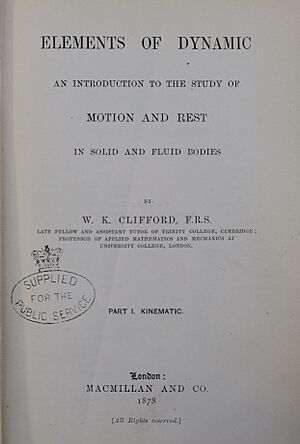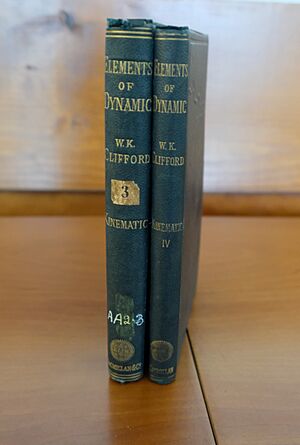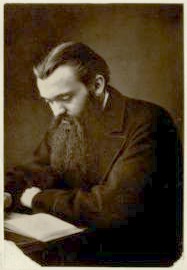William Kingdon Clifford facts for kids
Quick facts for kids
William Clifford
|
|
|---|---|
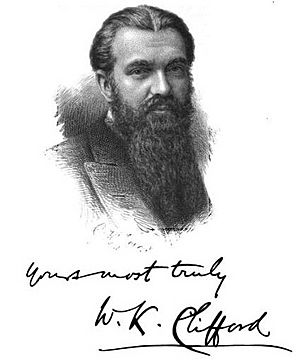
William Kingdon Clifford (1845–1879)
|
|
| Born | 4 May 1845 |
| Died | 3 March 1879 (aged 33) Madeira, Portugal
|
| Nationality | English |
| Alma mater | King's College London Trinity College, Cambridge |
| Known for | Clifford algebra Clifford's circle theorems Clifford's theorem Clifford torus Clifford–Klein form Clifford parallel Bessel–Clifford function Dual quaternion Elements of Dynamic |
| Spouse(s) | Lucy Clifford (1875–1879) |
| Scientific career | |
| Fields | Mathematics Philosophy |
| Institutions | University College London |
| Doctoral students | Arthur Black |
| Influences | Georg Friedrich Bernhard Riemann Nikolai Ivanovich Lobachevsky |
William Kingdon Clifford FRS (born May 4, 1845 – died March 3, 1879) was a brilliant English mathematician and philosopher. He built on earlier ideas to create something called geometric algebra. This is a special type of Clifford algebra, which is named after him. Geometric algebra helps us understand how shapes and objects move in space, like mirroring, spinning, or sliding them. Clifford algebras are very important in mathematical physics, geometry, and computing. Clifford was also one of the first to suggest that gravity might be caused by the shape of space itself. In his philosophical writings, he came up with the idea of "mind-stuff."
Contents
William Clifford's Life
William Clifford was born in Exeter, England. He was a very smart student from a young age. He went to King's College London when he was only 15. Later, he studied at Trinity College, Cambridge. In 1868, he became a fellow there.
In 1870, Clifford joined a trip to Italy to watch a solar eclipse. During this trip, his ship was wrecked off the coast of Sicily, but he survived!
In 1871, he became a professor of mathematics at University College London. He also became a member of the important Royal Society in 1874. He was part of other smart groups too, like the London Mathematical Society.
Clifford married Lucy Lane in 1875. They had two children together. William Clifford loved to entertain kids and even wrote a book of fairy stories called The Little People.
His Later Years and Legacy
In 1876, Clifford became very ill, probably because he worked too much. He taught during the day and wrote at night. He took a break in Algeria and Spain, which helped for a while. But after 18 months, he got sick again. He went to the island of Madeira to get better, but sadly, he died there from tuberculosis (a serious lung disease) after only a few months. He was just 33 years old.
Clifford and his wife are buried in Highgate Cemetery in London. This is near the graves of other famous thinkers like George Eliot and Karl Marx.
Today, an academic journal called Advances in Applied Clifford Algebras continues to publish research based on Clifford's ideas in mathematics.
Clifford's Mathematics
In Clifford's time, new ideas about non-Euclidean geometry were changing how people thought about space. This led to the study of differential geometry, which looks at how space itself can be curved, not just lines or surfaces within it. Clifford was very impressed by Bernhard Riemann's ideas about curved space.
In 1870, Clifford talked about Riemann's ideas at the Cambridge Philosophical Society. He even wondered if gravity could be caused by space bending. His translation of Riemann's paper was published in the journal Nature in 1873. Clifford's own paper, "On the Space-Theory of Matter", came out in 1876. This paper discussed ideas that were similar to Albert Einstein's general relativity theory, which came out 40 years later.
Clifford also worked on elliptic space geometry, which is a type of non-Euclidean geometry. Lines that stay the same distance apart in elliptic space are now called Clifford parallels.

People who knew Clifford thought he was very smart, funny, and kind. He often worked late into the night, which might have made his health worse. He wrote many papers on different math topics, including algebraic forms and projective geometry. He also wrote a textbook called Elements of Dynamic.
Clifford Algebras
In 1878, Clifford published a very important work. He managed to combine quaternions (a type of number system used to describe rotations) with Hermann Grassmann's "exterior product" (which helps describe areas and volumes). Clifford understood that these ideas fit together perfectly.
He created a "geometric product" that combined two important operations: the inner product (which deals with distances and angles) and Grassmann's outer product (which gives directions to areas and volumes). This new geometric product allowed for division in this system, which was a big step forward.
This new system, which Clifford called geometric algebra, helped mathematicians describe how objects move and project in 3D space. It was a long-sought goal to have an algebra that truly mirrored the real world.
Clifford's algebraic system also works for higher dimensions, not just 2D or 3D. The importance of general Clifford algebras has grown over time, and they are now used in many areas of mathematics and physics. For example, a type of Clifford algebra called dual quaternions is used to describe "screw displacement," which is a common movement in how machines work.
Clifford's Philosophy
As a philosopher, Clifford is known for two main ideas: "mind-stuff" and the "tribal self."
"Mind-stuff" was his idea about what makes up our minds. He thought that even the simplest things, like a moving molecule, have a tiny bit of "mind-stuff." When these tiny bits combine in complex ways, like in a jellyfish's nervous system, they form simple feelings. When they combine to form a human brain, they create human consciousness, with intelligence and the ability to make choices.
The "tribal self" is Clifford's idea about how we develop our sense of right and wrong. He believed that our conscience and moral rules come from a "self" inside us that wants to do what's best for our "tribe" or community.
Clifford was also well-known for his strong views on religion. He believed that people should always seek truth and do their public duty. He argued against religious systems that he felt encouraged obscurantism (blocking knowledge) or put the needs of a religious group above the needs of all people.
The Ethics of Belief
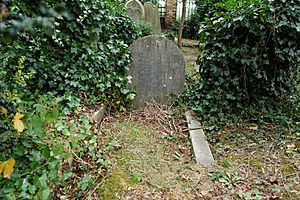
In his famous 1877 essay, The Ethics of Belief, Clifford argued that it is wrong to believe something if you don't have enough evidence for it.
He told a story about a ship-owner who was sending an old, poorly built ship full of passengers out to sea. The owner had doubts that the ship was safe, but he pushed these doubts away because fixing the ship would be expensive. He convinced himself the ship was fine. The ship then sank in the middle of the ocean, and everyone died.
Clifford said that the ship-owner was guilty of the deaths, even though he truly believed the ship was safe. Why? Because "he had no right to believe on such evidence as was before him." Clifford argued that even if the ship had made it safely, the owner's decision would still have been wrong. The morality of a choice is decided when you make it, not by what happens by chance later.
Clifford's most famous conclusion from this essay is called Clifford's principle: "it is wrong always, everywhere, and for anyone, to believe anything upon insufficient evidence."
This idea was very different from what some religious thinkers believed, as they valued "blind faith" (believing without evidence). Another philosopher, William James, famously disagreed with Clifford in his lecture "Will to Believe." These two works are often studied together to discuss the importance of evidence, faith, and belief.
Foreshadowing Relativity
Even though Clifford never created a full theory of spacetime and relativity, he made some amazing observations that hinted at these modern ideas.
In his book Elements of Dynamic (1878), he talked about "quasi-harmonic motion in a hyperbola," which later authors used to model relativistic speed. He also wrote about how the "geometry of rotors and motors" forms the basis for understanding how things move and rest.
Clifford also discussed his ideas about "the bending of space" in his 1876 paper, "On the Space-Theory of Matter." This was a key idea in general relativity.
Years later, after Albert Einstein developed his theory of general relativity, many scientists noticed that Clifford had thought of similar ideas much earlier. For example, Hermann Weyl and Eric Temple Bell pointed out Clifford's foresight.
John Archibald Wheeler, a famous physicist, even credited Clifford as the starting point for his own ideas about how gravity works. Clifford's ideas were seen as "strikingly prophetic" by many, even if they were not fully developed theories at the time.
Selected Writings
- 1872. On the aims and instruments of scientific thought, 524–41.
- 1876 [1870]. On the Space-Theory of Matter.
- 1877. "The Ethics of Belief." Contemporary Review 29:289.
- 1878. Elements of Dynamic: An Introduction to the Study of Motion And Rest In Solid And Fluid Bodies.
- Book I: "Translations"
- Book II: "Rotations"
- Book III: "Strains"
- 1878. "Applications of Grassmann's Extensive Algebra." American Journal of Mathematics 1(4):353.
- 1879: Seeing and Thinking—includes four popular science lectures:
- "The Eye and the Brain"
- "The Eye and Seeing"
- "The Brain and Thinking"
- "Of Boundaries in General"
- 1879. Lectures and Essays I & II, with an introduction by Sir Frederick Pollock.
- 1881. "Mathematical fragments" (facsimiles).
- 1882. Mathematical Papers, edited by Robert Tucker, with an introduction by Henry J. S. Smith.
- 1885. The Common Sense of the Exact Sciences, completed by Karl Pearson.
- 1887. Elements of Dynamic 2.
Images for kids
Quotations
"I…hold that in the physical world nothing else takes place but this variation [of the curvature of space]."
"There is no scientific discoverer, no poet, no painter, no musician, who will not tell you that he found ready made his discovery or poem or picture—that it came to him from outside, and that he did not consciously create it from within."
"It is wrong always, everywhere, and for anyone, to believe anything upon insufficient evidence."
"If a man, holding a belief which he was taught in childhood or persuaded of afterwards, keeps down and pushes away any doubts which arise about it in his mind, purposely avoids the reading of books and the company of men that call in question or discuss it, and regards as impious those questions which cannot easily be asked without disturbing it—the life of that man is one long sin against mankind."
"I was not, and was conceived. I loved and did a little work. I am not and grieve not."
See also
 In Spanish: William Kingdon Clifford para niños
In Spanish: William Kingdon Clifford para niños
- Bessel–Clifford function
- Clifford's principle
- Clifford analysis
- Clifford gates
- Clifford bundle
- Clifford module
- Clifford number
- Motor
- Rotor
- Simplex
- Split-biquaternion
- Will to Believe Doctrine


